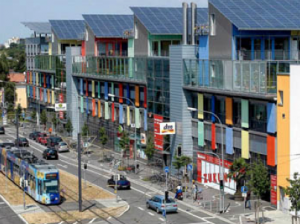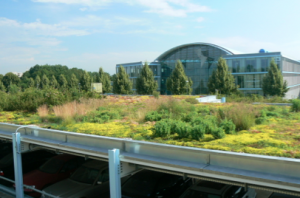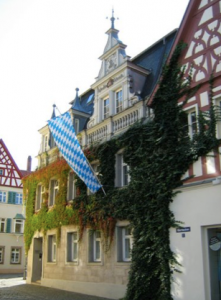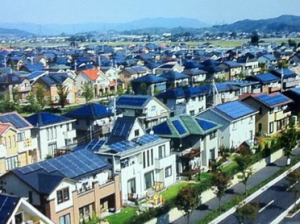Germany Goes Green—Environmentally and Economically
By Emily Barrus|December 04, 2012 2:55 pm
Imagine if all your commercial, educational, recreational, and social needs were just a quick walk or bike ride away from your residence; if you didn’t have to waste what feels like hours in rush-hour traffic, just to get home after a long day; if your roof had flowers and vegetation and the walls of buildings were covered in vertical gardens; if you got checks rather than bills from your energy supplier.
A world where all this is possible may seem impossible to the average American, but Germans have proven that sustainable growth is not only possible, but also economically advantageous. Sustainable growth uses natural resources in a way that both meets present human needs and protects the environment for future generations. It is often thought that sustainable practices are expensive, making them impractical to implement in a global economic crisis like the one we have been experiencing since 2008; however, Germany has changed its policies to make sustainable growth affordable.
A study conducted by Ralph Buehler has shown that the most remarkable changes in German society to sustainable practices have occurred in transportation, urban infrastructure, and energy.
Americans live in a society where owning a car is a necessity, but the same is not true for those who live in Germany. Germany’s modes of transportation are vastly different from those in America because German infrastructure caters to pedestrians, cyclists, and public transportation system users. This is because German communities mix residential, commercial, educational, and recreational land uses, making driving cars unnecessary since everything is a short walk, bike ride, or bus ride away. In other words, they practice mixed-use development.
Another reason why not many Germans have cars is the government has made owning a car and paying for gas more expensive than in America. This encourages Germans to own energy-efficient cars and utilize public transportation as often as possible. As a result, Germans spend 5% less on transportation than Americans.
Germans also have novel ways to save the environment and their pocket books through green infrastructure. Green roofs—roofs covered in vegetation—and green facades—vertical gardens on building walls—are examples of green infrastructure. Green infrastructure allows normally environmentally-intrusive constructions, such as buildings and roadways, to blend into the environment by mimicking natural processes that occur in soil and vegetation.
Germany encourages the use of green infrastructure through implementing building codes and nature protection laws. In America, new construction laws and codes are seen as hurtful to citizens, but these codes and laws do not come at a cost to German citizens; in fact, some help lower costs. For example, in Germany, each household is charged individually for the amount of storm water runoff from its property rather than each household being charged the same amount for storm water services no matter how much storm water runoff it produces. As a result, each household can decrease its costs for storm water services by implementing as much green infrastructure as possible.
How often have you seen solar panels being used for energy? If you live in America, chances are you have seen it rarely or maybe never. If you live in Germany, you see solar panels very often; you may even have one on top of your house. Unlike in America, the prices of renewable energy and non-renewable energy are compatible in Germany because the government prices non-renewable energy closer to its true value. As a result, Germans are encouraged to implement forms of renewable energy, such as solar panels. Germans benefit monetarily from using solar panels because German policy allows them to sell energy back to the grid. In other words, when the solar panels provide more energy than needed, the remaining energy produced is sold to an energy provider, resulting in profit gain for the household.
Germany has already twice surpassed the government-set goals for the expansion of renewable energy usage and is expecting 38% of the country’s energy usage to come from renewable resources by 2020. In contrast, the United State’s goal is for only 20% of the country’s energy to come from renewable resources by 2020. Germany’s increase in development of renewal energy has also benefited the economy by creating a new field of jobs, which employed around 340,000 people in 2010. This is almost 7 times the number of people employed by Germany’s coal industry.
German society, where sustainable growth in transportation, infrastructure, and energy is benefiting both the economy and the environment, is much different from American society, where unemployment rates are high and environmental protection is not a high priority on the government’ agenda. If there is anything that Americans should take away from Germany—“Europe’s Green Leader”—, it is that affordable sustainable growth, enabled through government policy, can not only stimulate the economy, but also preserve the environment in which we live.
Further Reading: “Germany’s Economic Engine”
Reference: Buehler, Ralph, Arne Jungjohann, Melissa Keeley, and Michael Mehling. “How Germany Became Europe’s Green Leader: A Look at Four Decades of Sustainable Policymaking.” Solutions 2.5 (2011): n. pag. Web. 19 Nov. 2012. <http://www.thesolutionsjournal.com/node/981>.
Categorized under: Environmental Science, Natural Science, Economics For more popular science writing, return from whence you came.



